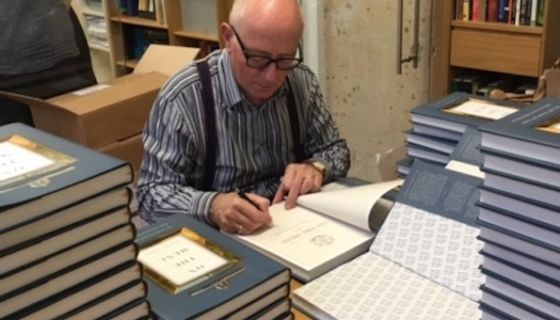My second book, On The Menu – The World’s Favourite Piece of Paper, is published today by Unbound at £30 (see the extracts published last Saturday). I am thrilled by the design of this extremely handsome book, 286 pages of high-quality paper with reprints of approximately 90 colourful menus from all over the world and across the centuries.

It is definitely not a history book but rather one that will, I hope, contribute to the better design of our menus in the future. On the Menu deals with the origins of the restaurant menu in Paris in the early 19th century. In interviews with 12 top chefs from France, Italy, the US, Australia and the United Kingdom, I quiz them on how they write their menus. One chapter deals with the importance of putting together a wine list to complement a menu, while a further chapter, over an interview with designer Mary Lewis of Moberly Lewis, the renowned design company, lays down the essential parameters for a successful approach to menu design.
History is not forgotten, however, and the final two chapters, ‘The Menu as Momento’ and ‘The Menu as Edible Art’, contain reproductions of menus from the golden age of menu design, between the 1920s and 1960s and principally in the US.
That was when a combination of factors came together that led to a most propitious state of affairs for the design of menus. It was an era of individual restaurateurs. It was a time when the pen, and imagination, of the graphic artist was given full rein. It was when Americans were beginning to travel in great numbers, principally by car. It was at a time when the menu was still considered the least expensive form of propaganda, of spreading the restaurant’s name. And it was in an era before the internet.
Today, things are very different. Too many restaurants are part of groups, often controlled by venture capitalists who are very keen on their positive cash flow but insist on a rather utilitarian approach to menu design to keep costs down. And then there is the internet. In my opinion, a website is now considered by many as the restaurant’s most important form of communication, with its menu there but definitely somewhat secondary. I make a point of never looking at a menu online before I go there professionally or even socially to eat out.
That is not to dispute the fact that some of today’s menus are things of beauty. A clean, crisp, single sheet of paper – with desserts and cheese to be shown on a separate piece of paper once the main courses have been finished – bearing that day’s date at the top, is a clear indication that the chef, and the restaurateur, have their customers’ best interests at heart. All these sentiments are to be encouraged.
But more can, and should, be done. More colour, less black ink, would be the first step. Less reliance on in-house printing may be one step but I cannot really see that happening. But my main impetus for writing this book has been twofold.
My first aim is to impress on chefs and restaurateurs quite how important their menu is, quite how much pleasure this single piece of paper generates – more than any other in the world, I would argue – and why in our increasingly time-pressured world customers have less and less time to read a menu and focus their attention on all the good things that lie behind it.
The second is to set the menu in perspective. I got the impression a couple of years ago that nobody to date had focused their attention on this piece of paper that has been a part of my daily life for over 30 years and has been around for over 200 years. Nobody had bothered to look at it either critically or to set it in perspective. Fortunately, my thinking coincided with that of John Mitchinson, one of the founders of Unbound, the crowd-funding publishing house, and our successful collaboration began. We started the process in spring 2015 and finished on time, 18 months later.
Finally, during the period of fundraising when this book was ‘inside me’, as it were, I had the chance to think about some of the factors that affect the menu. One, of course, is the wine list and here I was able to write a pretty comprehensive chapter with the help of our Spanish specialist Ferran Centelles from Barcelona, Enrico Bernardo from Il Vino in Paris, and Xavier Rousset, Charlie Young and Charlotte Sager-Wilde from London.
I believe that we may have got the timing of this book just right. On Tuesday morning I was interviewed by Markus Hippi for on-line radio station Monocle 24’s The Menu programme that will be broadcast at 7 pm on Friday 11 November. While we were waiting for the producer to give us the red light, he asked me, ‘Don’t you think that there is a lot of attention being put on menus at the moment?’ I had, for altruistic and very selfish reasons, to agree with him.













